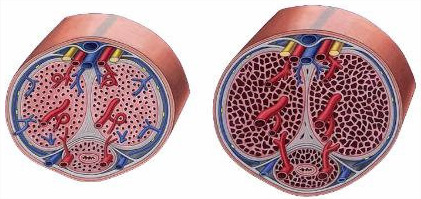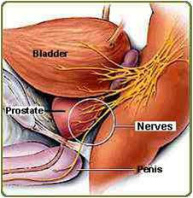Erectile dysfunction (ED) is defined as the inability to attain or maintain an erection of satisfactory quality to complete intercourse. It is sometimes referred to as impotence. The degree of ED can range from mild cases where there is a slightly diminished rigidity in the penis to severe cases where a man is unable to attain any erection.We know that the incidence of ED increases with age and that approximately 25 million Americans suffer from this condition making it one of the most common sexual problems in men. The incidence in 40 year olds is around 5-10% and increases to 25-30% in 65 year old men. Some studies have shown that up to 50% of men over the age of 50 have ED.
How Does an erection occur?
The penis is an organ made up of two chambers called the corpora cavernosa that run along the full length of the penis. These chambers are filled with a spongy tissue made up of smooth muscle that becomes filled with blood, expands in size and becomes firm. The corpora are surrounded by tough connective tissue called the tunica albuginea.


Normally functioning nerves are also important for an erection. These nerves originate from the spine and run along the prostate until they reach the penis. These nerves give the penis the signal to start an erection. An erection is a very complex process involving coordinated normally functioning arteries, veins and nerves. In addition to the above, an normal erection also requires a normal level of testosterone. Adequate sensory stimulation from the brain is important for the initiation of an erection.
Since an erection requires a precise sequence of events, ED can occur when any of the events is disrupted. The sequence includes nerve impulses in the brain, spinal column, and area around the penis, and response in muscles, fibrous tissues, veins, and arteries in and near the corpora cavernosa. The vast majority of cases of E.D. have an organic etiology. Organic causes of E.D. account for 90% of cases of this condition
Damage to nerves, arteries, smooth muscles, and fibrous tissues, often as a result of disease, is alcoholism, multiple sclerosis, atherosclerosis, high blood pressure, vascular disease, and neurologic diseaseaccount for about 70 percent of ED cases. Between 35 and 50 percent of men with diabetes experience ED. Damage to the nerves causing erection can occur with prostate, colon or pelvic surgery or radiation.
The choices we make in life can lead to degeneration of the erectile tissue and the development of ED. Smoking, drug or alcohol abuse, particularly over a long period of time, will compromise the blood vessels of the penis. Lack of exercise and a sedentary lifestyle will contribute to the development of ED. Correction of these conditions will contribute to overall health and may in some individuals correct mild ED. Treatment of many medical conditions can interfere with normal erections. Drugs used to treat these risk factors listed above may also lead to or worsen ED.
In addition to understanding the causes of E.D. it is also important to recognize that E.D. may be an early warning sign of more serious medical conditions such as atherosclerosis and heart disease. Emerging research has shown us that up to 50% of men with isolated E.D. as their only symptom will go on to develop heart disease or atherosclerosis in the subsequent 5 years. In essence, we need to look at E.D. as an early warning sign for a much more serious condition and not only treat it as an isolated symptom.
Back To Top
How is erectile dysfunction (E.D.) diagnosed?
Erectile dysfunction is diagnosed by taking a thorough history and performing a physical examination. Your doctor might ask you to fill out a questionnaire to better evaluate the degree of erectile dysfunction. Laboratory tests include hormonal evaluation, PSA, and possible cardiac profile testing. Your doctor might recommend evaluating the blood flow in your penile arteries using a Doppler Ultrasound. This is a non-invasive test , however, the test needs to be performed with a flaccid and erect penis and this can only be accomplished by injecting a medication into the penis causing an erection. This is done with a tiny diabetic needle. Additional testing with biothesiometry, corpus cavernosometry and cavernosography,nocturnal penile tumescence and angiography is only recommended in select situations.
evaluate the degree of erectile dysfunction. Laboratory tests include hormonal evaluation, PSA, and possible cardiac profile testing. Your doctor might recommend evaluating the blood flow in your penile arteries using a Doppler Ultrasound. This is a non-invasive test , however, the test needs to be performed with a flaccid and erect penis and this can only be accomplished by injecting a medication into the penis causing an erection. This is done with a tiny diabetic needle. Additional testing with biothesiometry, corpus cavernosometry and cavernosography,nocturnal penile tumescence and angiography is only recommended in select situations.
Back To Top
How is erectile dysfunction (E.D.) treated?
There are several treatment options available for men with erectile dysfunction. Dr Karpman will discuss any and all available treatment options. A treatment plan will be tailored to every individual’s needs. The optimal goal is to provide the least invasive yet most effective treatment that reliably delivers a firm and solid erection that is adequate to have penetrating intercourse of adequate duration to satisfy both you and your partner. The treatment options include:
- Oral medicines (Viagra, Cialis, Levitra)
- Penile Rehabilitation
- Hormonal Therapy
- Urethral Suppositories
- Vacuum Erection Device (VED)
- Penile Constriction Bands
- Penile Injection Therapy
- Penile Prosthesis
Back To Top
Are there any natural alternatives to E.D. treatment?
Included a list of over-the-counter medications that have been shown to be successful to some extent in treating erectile dysfunction. It is important to note that any neutraceutical (herbal, over-the-counter) treatment is not evaluated or approved by the FDA and therefore not subject to the scrutiny that prescription medications must undergo in terms of substantiating claims made by the manufacturers or in quantifying the purity of these products. Use of these alternative medications is at your own risk.
Arginine
This is a precursor amino acid to nitric oxide. Human clinical trials have yielded mixed results. Up to 40 % of patients in one trial reported improvement in results, whereas other trials have shown no improvement. It appears more effective in ED patients with alterations in endothelial L-arginine-NO activity and a reduction in NO availability.
Yohimbine
This is a centrally acting alpha-2 antagonist which causes a reduction in brain norepinephrine levels. Human clinical trials have yielded mixed results. A randomized double blind placebo controlled crossover study showed that 14% of the treatment group experience full-stimulated erections and 20% had a partial response.
Panax Ginseng
This is found to possess antioxidant and organ-protective action associated with enhanced NO synthesis in the endothelium of the corpus cavernosum. Ginsenosides have been shown to cause a dose-dependent relaxation of the corpus cavernosal smooth muscle in rabbits by increasing release of NO. A double blind placebo controlled crossover study showed significant improvements in IIEF scores and penile tip rigidity by Rigiscan.
Maca
This is a root vegetable cultivated in the central Peruvian Andes that belongs to the mustard family. Dried Maca root is rich in amino acids, iodine, iron and magnesium. This also an aphrodisiac with fertility enhancing properties. There is only one human randomized double blind placebo controlled trial published in a Peruvian journal. This root improved subjective evaluation of sexual desire in treated men. No other information was attainable.
Ginkgo Biloba
Used to ameliorate antidepressant-induced sexual dysfunction. Initial open label human trials showed it to be 76% effective in alleviating symptoms related to all phases of the sexual response cycle in men, including erectile function. However, a subsequent double blind RCT reported no significant difference in sexual function between ginkgo and placebo.
DHEA and Tribulus Terrestris
Inverse relationship between DHEA and ED has been well established in the Massachusetts Male Aging Study. A double blind RCT in humans using DHEA 50mg has shown an improvement in achieving and maintaining erections sufficient for satisfactory sexual performance compared to placebo. However, a small sample size made conclusions from this study difficult. An extract called protodioscin extracted from Tribulus terrestris plant improves erectile function, increases sexual function and improves sexual behavior. Most of this information comes from Hungary and is published in small journals.
Back To Top
Go Back to Services

